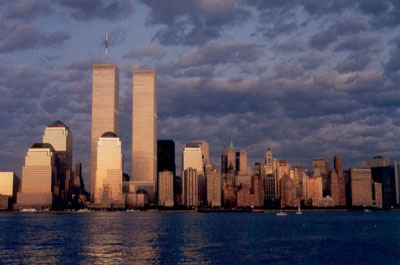I published the following on September 11th, 2004, on another site I had back then. That site having gone the way of homepage.mac.com, I thought I’d reunite this post with the rest of my 9/11 series.
Plenty has happened in the decade since, and I’m glad to see that we did ultimately rebuild at the World Trade Center site, even as I’m still concerned that it took us as long as it did.
In September 2001, I was living about 110 miles up the Hudson River from New York City. According to published flight path information, American Airlines Flight 11 passed not so very far from overhead on that morning three years ago, on its way toward New York City and its collision with the north tower of the World Trade Center. I visited Ground Zero two weeks after the terrorist attacks, at which time the fence perimeter allowed one to get within two blocks or so of the site — close enough to experience the twisted wreckage of the towers’ remaining outer walls, the debris everywhere, the people working to search for human remains and clear the site, as something undeniably real. And amid the complex knot of feelings that continued to unravel in the sunken pit of my stomach — including the struggle to address the seemingly impossible question of how any human being could be capable of following through on, much less conceiving of such a vicious attack — I also felt, and still very much feel today, a strong conviction about at least one thing: Ultimately, we must rebuild.
Why care so much about putting some new buildings in Lower Manhattan? After all, the catastrophe of that day is over, its victims irreversibly claimed. Nothing we do now can bring them back to us.
I care about what we do to rebuild, because the towers symbolize something positive to me — they were monuments to human progress, to what people in a free and voluntary society are capable of achieving. And I care because I see vital symbolism in the act of rebuilding itself, of finding and enacting a design that not only mourns respectfully “They are gone”, but also affirms with conviction “We are still here.” That our culture is not going away; that we will continue to aspire, dream, strive, design, build, achieve, and live, in many ways, as we have. That we will create our own future rather than accept the fate chosen for us.
But how to rebuild? What to construct in the emptiness where the towers once stood? For me, architect Sherri Tracinski hit on the key issue in her 2002 article written in disappointed response to earlier WTC redevelopment proposals for buildings that fell short of the the Twin Towers’ stature:
Anything less than a new tower at the same height — or higher — is demonstrating to those who hate us that we intend to cut back, roll over, and give up. It is not the quick, violent suicide of putting a gun to your head, but the slow suicide of a man who has given up trying to live.
“Throughout history,” she reminds us, “many great buildings have been damaged and destroyed in war. What a society does to rebuild afterward is an omen for its future survival.” [emphasis mine]
Twenty-five hundred years ago, a marauding Persian army sacked the Greek city of Athens and burned the Parthenon, the city’s most important temple. What did the ancient Athenians do? They didn’t decide they should make a smaller temple so that it would be less of a target in the future. They didn’t decide that they were guilty of offending the enemy with their wealth and success. They didn’t leave a barren plateau to commemorate the men who died fighting the Persians. Instead, after they roundly defeated the enemy, they rebuilt bigger and better.
The old Parthenon had been built of limestone. The new Parthenon was built of the finest material the Athenians could find—white marble—and decorated with inspiring sculptures of heroes. It was the greatest Greek temple ever built and marked the beginning of the Athenian “Golden Age.”
It is in the wake of historic precedents such as this one that we are left to decide what it is that we will do. Will we “cut back” half-heartedly? Or will we summon the will to replace what was taken from us with something still more ambitious? In July, the cornerstone was laid for the first and tallest building now scheduled to be constructed at the site. The planned “Freedom Tower” would, at 1,776 feet, stand taller still than did the 1,362 and 1,368 foot Twin Towers. Yet if the tone and content of last Tuesday’s Frontline report “Sacred Ground” is to be believed, the construction of the tower seems anything but certain — jeopardized by infighting among rival architects Daniel Libeskind and David Childs, developer Larry Silverstein, the Lower Manhattan Development Corporation and the city and state governments of New York. Will we blow it by letting the project become mired in egos and politics? Will we be persuaded that we shouldn’t even care — or maybe, just maybe should even be glad to see the towers gone?
It’s at this point that I struggle to fathom stuff like this. It takes a pretty twisted worldview to attempt to brush aside the viciousness and human toll of September 11th and invoke a phrase like “radical architectural criticism” to describe the deliberate flying of aircraft full of people into buildings full of people. People, some of whom chose to jump to their deaths rather than accept the fate that had been chosen for them. Maus creator Art Spiegelman really ought to know better. And he ought to know all about what life in an actual police state is like. James Lileks takes him deservedly to task, on the eve of publication of Spiegelman’s In the Shadow of No Towers. (There’s no anchor, so you’ll have to scroll to about the bottom third of the page to find the part about Spiegelman. There’s a pointed note about journalism and the recent carnage in Beslan along the way. Link courtesy of Instapundit.)
That’s how Spiegelman would have us feel about the towers, our culture, and ourselves? Thanks, Art. We’ll remember that.
Clearly there is nothing to stop us from succumbing to this kind of thinking if we choose to do so. How we respond, how we move on, is our choice. I’m moved to remember Senator McCain’s words as he declared in his gentle, measured tone, “What our enemies have sought to destroy is beyond their reach. It cannot be taken from us. It can only be surrendered.” And so indeed, it is left up to us to decide what to do next. We can resign ourselves to accept empty footprints and a hole in the sky, or some modest concession, where the towers once stood. Or we can rebuild with determination to reach still greater heights.
Those who perished needlessly in New York, Washington D.C., and Pennsylvania, can never be replaced. But I believe we can best honor their memory by our commitment to keeping our enterprising culture alive and thriving.

What we have built still stands tall in our hearts.
Links
Frederick Turner’s “Honor in the Sky” provides another interesting take on the meaning of rebuilding, and offers the imaginative if maybe not practical (?) idea of placing a garden memorial atop the new building(s).
Team Twin Towers [link broken] hosts a page of comments from survivors and others who would like to see the towers or something like them rebuilt.
Wikipedia:
Another 9/11 has rolled around. And while the grief and anger are still there, and we have renewed cause for concern this year in the rise of ISIS/ISIL, I find that my feelings seem not particularly more pronounced on this day relative to any other. The problems that we are obliged to squarely face endure, and are relevant every day of the year, not just on anniversaries of the September 11th, 2001 Jihadist attacks on the United States.
The sickening brutality of ISIS/ISIL and its ideological fellow travelers such as Boko Haram has been something for the world to behold. If we cannot now see with complete clarity what these scumbags are about, I don’t know what it will take. The fact of things as I see it is that ISIS/ISIL are but a particularly awful symptom, one that is enabled and allowed to exist only to the extent that we lack the resolve to call them what they are and commit ourselves unreservedly to their complete and unconditional defeat.
The broader, underlying problem we face is an erosion of cultural confidence, and I’m sad to say it’s the predictable result of decades of steady, dedicated work by many among us — people whose aim has been to demoralize us and gradually chisel away at the foundations of our belief in who we are and the way that we live. An event such as 9/11 should have brought us to our senses, it seems to me, and brought an end to that idle self-doubt, seemingly born of boredom with years of relative safety and security. But I’ve been proven more wrong in that expectation than in any other of my life. Rather than have a change of heart, our cultural termites dug in and continued their toil. It makes no sense to me to see a culture of great achievement, worthy of celebration and of a strident and confident defense, in such willful and sometimes self-recriminating denial about the threats posed to it. But there it is. It’s an aspect of human nature that I suspect I will continue to struggle to understand for many years to come.
I do feel I’ve made progress, though, in casting off the shadow of gloom this past year and a half or so. It feels as if my thinking has shifted to a point of: OK. So that’s how it is. What are you going to do about it?
Our present condition is not cause to sit in idle resignation. It’s cause to get up, dust ourselves off, and fix the things that matter. And despite all the potential reasons for gloom, I’m doing it with gratitude in my heart, a cheerful demeanor, and a smile on my face — because I’ve learned that no matter what, one cannot allow others to drive him to despair. To have hope of prevailing, we must maintain a steady and undaunted focus on all that is positive in our love for what we hold dear. We must make that love stronger, more resilient, and more lasting than our enemies’ bitterness, brutality, and hate. It’s what I’ve been striving to do, and aim to continue to do, with The No Fear Pioneer (so please give a listen, and stay tuned for more to come).
That’s it for now. As in previous years, I may follow up with some links and quotes later, as I read good work by others. Below are links to my previous years’ 9/11 posts, including the 2009 retelling of my own peripheral but deeply affecting experience of that awful day. As before, I pledge myself never to forget — nor misremember. May we find our way to better times.
My Previous Years’ 9/11 Posts
2013: 9/11, Twelve Years On
2012: 9/11, Eleven Years On
2011: A Plea, Ten Years After: Please, Open Your Eyes ~ Ten Years Later: 9/11 Links
2010: 9/11: Two Songs
2009: Tomorrow is 9/11 ~ My Experience of September 11, 2001 ~ 9/11 Quotes
2008: 9/11, Seven Years On ~ 9/11, Seven Years On, Part 2 ~ 102 Minutes that Changed America
2007: 9/11, Six Years On
2006: Soon, Time Again to Reflect ~ 9/11 Observances ~ 9/11 Observances, Part 2
2005: I Remember
2004: Remembering and Rebuilding (republished here September 12th, 2014)
Closing the loop on an earlier post: I’m glad to report that the house hunt I was so apprehensive about has reached a happy conclusion. All it takes, in the end, is one “right” place, and I’m very grateful to have finally found it. My wife and I closed last week on a neat old place (farmhouse colonial, built circa 1887) that has a reportedly excellent elementary school for our soon-to-be-kindergartner less than a mile away.
Like any house that age, it’s going to need some work, despite having been well cared for overall, but I’m enjoying the opportunity to do that work and get to make the creative decisions that go with it. After going back from being a homeowner to a renter three years ago, I’m happy to return to a situation of greater ownership and investment — something we can build on and make truly our own. The place has a tranquil feel to it that puts me at ease. — It’s a welcoming retreat that I’ve yearned for without fully realizing it. I think the experience of it will help me to get where I’m striving to go, and for that I am grateful.
The anticipated school challenges I wrote about still loom, but I think we’ve made a choice that gives us a strong foundation for grappling with them. My sons, 5 and 2, continue to amaze me with their natural curiosity and aptitude for learning, and I have strong hope that I can put all that I’ve learned to work, anticipating challenges and helping them learn how to find their bearings and succeed.
So I guess renovating and home improvement projects will be my new excuse for not writing here more often. I’ll try not to overuse it. There’ll be some inevitable extra demands on my time while we get set up and settled in, but once things have returned to a steady state I look forward to re-engaging on other projects that matter a great deal to me, including writing here and producing more No Fear Pioneer episodes.
My move from Blogger is effectively almost complete, by the way. I’ve ceased posting at fearlessdream.blogspot.com, and will be publishing new material here at fearlessdream.us. I just need to get around to adding a notice at the old site and a redirect to this one. Always something to do!…
Thanks for visiting. I look forward to getting to more of the interesting stuff that’s swimming around in my head in the near future…!
I’m happy to be back after a too-long hiatus, reflecting on the venture I discussed in Episode 4, and lessons learned. Have a listen on the new podcast page, or on iTunes or Stitcher!
Welcome! …and pardon our dust!
While I work on migrating “Fearless Dream” to WordPress hosting, please find all the old familiar site features here:
Soon, you’ll see a consistently themed landing page here at fearlessdream.us, and I’ll have a much more flexible publishing platform to use.
Thanks for your patience while I get this all sorted out!
-Troy
It’s time to start writing and publishing here again. Straining to get a business off the ground while raising two young boys, it’s been hard to find the time, but there are challenges ahead that I’m going to need to work out how to deal with, and working through my thoughts in writing seems more likely than anything else to help. I also feel the need to do something useful to help turn this culture of ours around — or, if that isn’t possible, at least help others to navigate a way out — so it’s time to make time.
With my older son on the verge of turning five, kindergarten and all that follows it are suddenly looming near — a prospect that brings me no small amount of dread and apprehension.
In part, I’m concerned because of my own difficulties with public school education — difficulties that, in summary, cultivated in me such a strong dislike for formal education that I waited four years before going to college and repairing that relationship. (Thankfully, college is not high school by any stretch. Having found a passion for physics through self-motivated study on my own, I devoted my very best efforts, and graduated with high honors.)
It’s absolutely vital to me that I not allow my own children to needlessly suffer the same troubles. (Yes, some part of it was a character-building learning experience, but much of it was a completely unnecessary impediment to my progress.) Given that my oldest son has a highly curious, creative mind that asks and can understand the answers to advanced, insightful questions, I’m thinking similar personality + similar school system = similar result, and I dread the thought of that.
I’ve also become aware that schools, and in particular public schools, have not only limitations but complex agendas whose constituent parts can come into conflict with my child’s best interests. Some have social goals, to which they may at times subordinate their students’ individual interests and advancement. To have my child’s future or development sacrificed in this way is unacceptable to me, and it’s something I’m braced to be ready to fight tooth and nail against.
Indoctrination? I suppose I should be worried about that too, and I am, a little, but not so much in the near term. I made it though junior and senior high school without encountering anything overtly troubling (though I now realize I was offered only partial truth about some things). But I’m well aware that my experience may not have been the norm, and that things have also had ample time to “progress” in the past … *ahem* … few decades. (Following Glenn Reynolds’ “K-12 Implosion Update” series is certainly enough to make one worry about the state and sanity of present-day education.) I’m fine with my kids having honest exposure to a wide range of ideas and being free to choose for themselves what philosophies they adopt, so long as they acquire the skill of applying research, reason, and common sense to discern truth. I wouldn’t want it any other way. When things are slanted, however — whether by omission or otherwise — to comport with an ideological agenda that discards hard-won lessons about the meaning of liberty, the origins of tyranny, and all that we have to be genuinely grateful for … well, then we’ll have a problem.
Whatever the long-term problems might be, the immediate challenge is to figure out where the best (least bad?) schools for our sons are located, and move accordingly. Given that all the towns within a reasonable distance from my wife’s job (my work is portable, currently) exact a steep property tax to fund their public schools (with rates around 2% vs. California’s 1%, and house prices comparable to California’s, your annual property tax bill comes to around $12,000-16,000), we had better hope that the local public schools will be good enough for the time being. Else, we’re going to have to find a way to pull in enough additional income to pay private school tuition on top of the cost of the public schools we’ll be paying for but not using.
I imagine large numbers of parents fall into the strategy of relying on a public schools of necessity, while supplementing with outside programs to fill in the weak spots, and striving to cope on their own with the problems public schooling creates and undo any damage that gets done. I certainly don’t expect that I can leave my children’s education to any school system. — That seems like folly, no matter how good the schools. Rather, I expect to be deeply involved in my children’s learning, doing whatever it takes to make the time for it to be a priority. It’s a long road ahead, that I’m sure many of you reading this have probably traveled already. I welcome advice, and will be actively seeking out as much useful information as I can find in the months and years to come. I expect a long, hard climb, but nothing could be more worth the effort than helping my children find their bearings and get off to the best start possible to happy and fulfilling lives.









